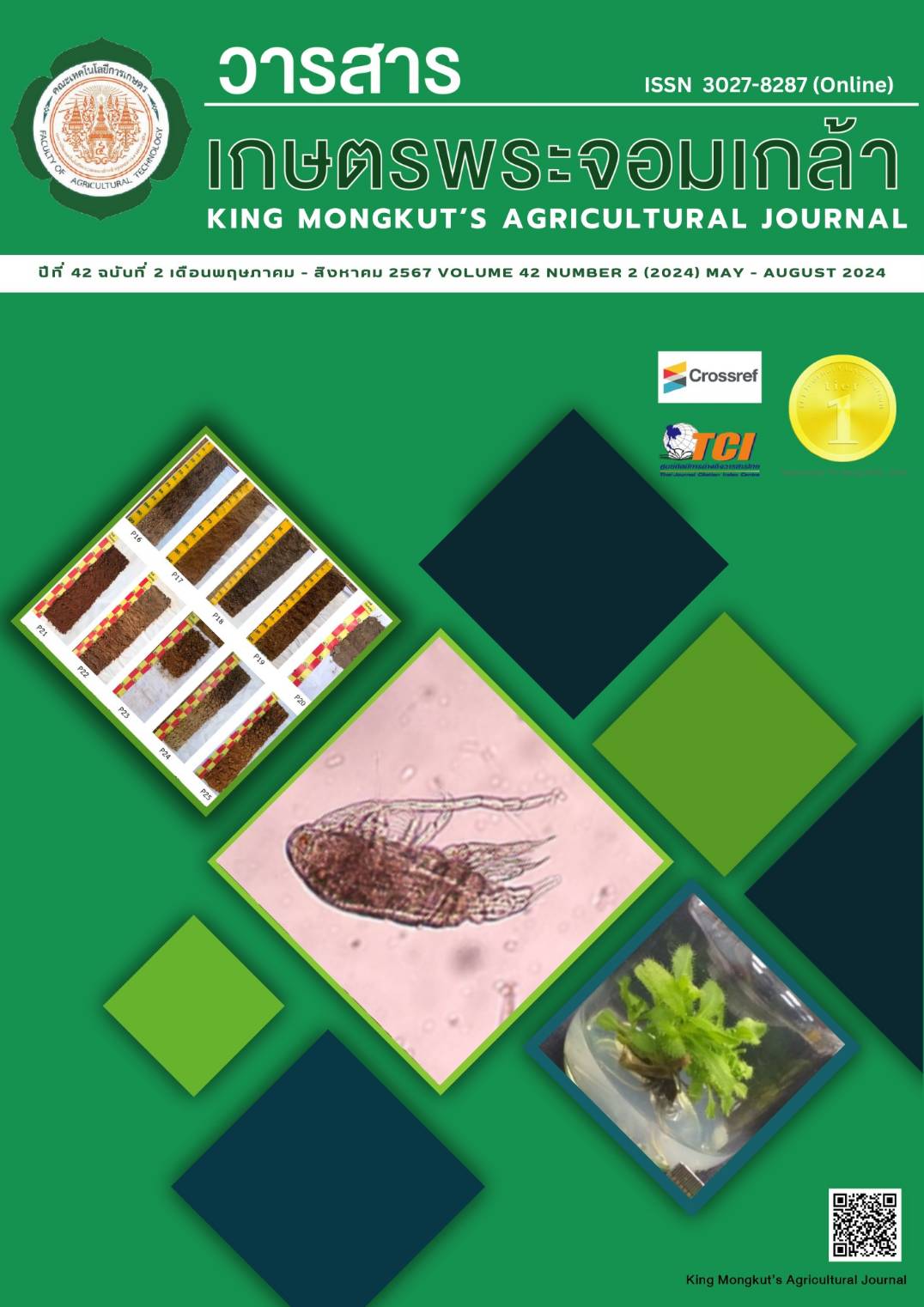Effect of BA on Callus Induction, Shoot and Root Development from Callus of Nepenthes ampullaria through In Vitro Culture
Main Article Content
Abstract
Nepenthes ampullaria Jack. or pitcher plant is a carnivorous plant in the Nepenthaceae family. They are in danger of extinction because of the less forest area, volatile weather, and pollution. This study aimed to investigate the influence of BA (6-benzyl adenine) on callus induction of Nepenthes sp. through In vitro culture. The experiment was divided into three parts; (1) Callus induction; shoot of a pitcher plant were cultured on solid MS medium (Murashige & Skoog, 1962) supplemented with BA (6-benzyladenine) at 0, 1, 2, and 4 mg/l for 70 days. The experiment design was completely Randomized Design (CRD) (4 treatments X 10 replicates). It was found that MS medium supplemented with 4 mg/l BA proved to be a suitable medium for callus induction (70%). (2) Shoot induction from callus; callus were cultured on MS medium supplemented with 0, 2, and 4 mg/l BA (CRD, 3 treatments X 10 replicates) for 45 days. The highest average number of regenerated shoots (19.7±0.3 shoots) was observed on MS medium without BA. (3) Rooting induction; the young shoots, 1-2 cm in length, were cultured on MS medium containing 0, 1, 3, and 5 mg/l NAA combination with 0 and 3 mg/l IBA for 40 days (CRD, 8 treatments X 10 replicates). The results showed that the MS medium supplemented with 1 mg/l NAA and 3 mg/l IBA was suitable for root induction with the average of 7.4±1.6 roots.
Article Details

This work is licensed under a Creative Commons Attribution-NonCommercial-NoDerivatives 4.0 International License.
King Mongkut's Agricultural Journal
References
Ai-sulaiman, F. A., & Barakat, M. N. (2010). In vitro shoot multiplication of Ziziphus spina christi by shoot tip culture. African Journal of Biotechnology, 9(6), 850-857.
Balachandar, R., Alagumanian, S., Perumal, V. S., Rameshkannan, K., & Rao, M. V. (2004). Plant regeneration from leaf and stem explants of Solanum trilobatum L. Current Science, 86(11), 1478-1480.
Chamandoosti, F. (2020). Citrus tissue culture with two different approaches. International Journal of Biosciences and Biotechnology, 8(1), 19-30.
Charoenwattana, P., Srion, P., Chiablaem, K., Ploykerd, K., & Hongthong, P. (2018). Effects of Cytokinins on Shoot Induction of Nepenthes mirabilis in vitro. Agricultural Science Journal, 49(Suppl.3), 149-153.
Cui, Y., Deng, Y., Zheng, K., Hu, X., Zhu, M., Deng, X., & Xi, R. (2019). An Efficient Micropropagation Protocol for an Endangered Ornamental Tree Species (Magnolia Sirindhorniae Noot. & Chalermglin) and Assessment of Genetic Uniformity through DNA Markers. Scientific Reports, 9(9634), 1-10. https://doi.org/10.1038/s41598-019-46050-w
Jaisue, C., Poowan, N., Kanjanasopa, D., Srirawat, T., Thitithanakul, S., Onsanit, S., & Sontikun, Y. (2019). Random Amplified Polymorphic DNA (RAPD) analysis of somaclonal variation among in vitro Nepenthes mirabilis. Khon Kaen Agriculture Journal, 47(Suppl.1), 515-522.
Jala, A. (2012). Types of media for seeds germination and effect of BA on mass propagation of Nepenthes mirabilis Druce. American Transaction on Engineering and Applied Sciences, 1(2), 163-171.
Kanchanapoom, K., & Boonvanno, K. (2000). A protocol for micropropagation of the piscicidal plant Maesa ramentacea A. Dc. Science Asia, 26, 201-205.
Khompat, K. Tokhao, W., & Jantasilp, A. (2007). Factors affecting in vitro seed germination and shoot multiplication of a pitcher plant (Nepenthes mirabilis Lour Druce). Songklanakarin Journal of Science and Technology, 29(2), 253-260.
Khumdinpitag, A., Krasaechai, A., & Phornsawatchai, P. (2004). In vitro Propagation of Pitcher Plant (Nepenthes thorelii). Journal of Agriculture, 20(1), 1-9.
Kumlay, A. M., & Ercisli, S. (2015). Callus induction shoot proliferation and root regeneration of potato (Solanum tuberasum L.) stem node and leaf explants under long-day condition. Biotechnology and Biotechnological Equipment, 29(6), 1075-1084.


